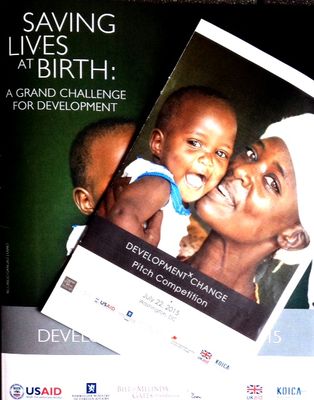“It’s heartbreaking to not have the medical equipment to save a baby. Saving a life–well, it’s the most amazing feeling in the world,” said Indira Chikomoni, a nurse from Rwanda said in the opening video at the recent DevelopmentXChange Marketplace that took place July 22nd in Washington, DC.
For the past month, Innovations in Healthcare (in partnership with Permjot Valia, CEO and Founder of MentorCamp) has had the opportunity to work with USAID and the Saving Lives at Birth program preparing grantees to present at DevelopmentXChange. These grantees represent the most promising innovations in maternal and child health – drawing on top intellectuals from leading academic institution and ultimately looking to translate research into saved lives. Innovations are coming from organizations like Sisu Global which can autotransfuse blood, salvaging 1-2 units of blood; Nanobiosym which provides diagnostic testing 10 times cheaper than alternative devices on the market; and Bioceptive which offers an easy to use IUD inserter.
After 14 pitches, one dynamic panel and a marketplace showcasing over 50 maternal health innovations, a few themes stood out:
- Academic research and entrepreneurship are not the same. Inventing a solution and turning that solution into a business or commercial product requires different skillsets and experience. Innovation is needed to bridge both sectors. There is a tremendous opportunity to improve this link in the future.
- To be successful, entrepreneurs need to demonstrate they understand the market; who the payer is and who the end user is; the cost of their device; and their go to market strategy. Investors are actively investing in new devices and diagnostics with large scale impact potential. But they know these markets are also extremely competitive.
- Risk matters greatly. The upside of a new device can be huge when people are trained in the right way—saving babies and mothers lives in a dramatic way. But entrepreneurs must also understand the impact if the device is used improperly. Ensuring lives are not harmed is equally important.
- Growth in this sector very much needs patient capital – a mix of grant funding for research, equity for commercialization and low-interest working capital for purchase orders. Innovation in this sector isn’t easy and the entrepreneurs driving new ideas forward should be greatly commended. Successful companies require both the speed of entrepreneurship and the attention to detail of clinical trials and research. Compounding the challenge is the need to adapt technologies for low-resource settings where electricity or proper training cannot always be counted on.
It’s an exciting time to be an entrepreneur and the potential to impact change is incredible. Innovations in Healthcare (formerly IPIHD) is currently looking for the best and brightest healthcare entrepreneurs to join our elite network. Nominate your organization or an organization you think is excellent through August 14th. Learn more here: http://innovationsinhealthcare.org/apply-to-be-an-innovator

